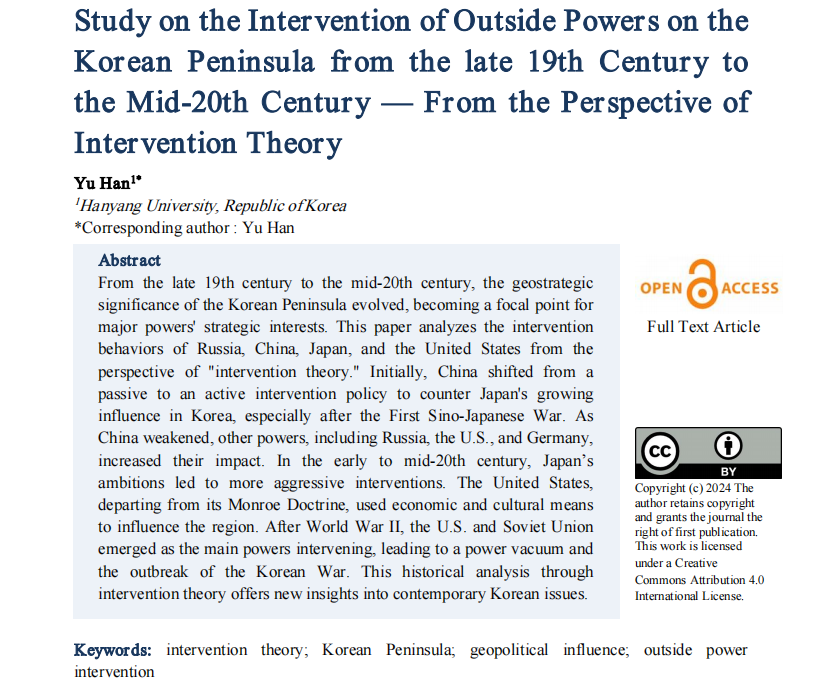Study on the Intervention of Outside Powers on the Korean Peninsula from the late 19th Century to the Mid-20th Century — From the Perspective of Intervention Theory
DOI:
https://doi.org/10.5281/zenodo.14548172Keywords:
intervention theory, Korean Peninsula, geopolitical influence, outside power interventionAbstract
From the late 19th century to the mid-20th century, the geostrategic significance of the Korean Peninsula underwent substantial changes, transforming it into a tool for major powers' strategic games and thereby endowing it with unique geopolitical importance. This paper aims to use the Korean Peninsula as a case study, tracing the political landscape and events of the region through a historical lens, and then analyzing and commenting on these from the perspective of “intervention theory”. From the perspective of intervention theory, this paper will analyze and sort through the intervention behaviors of Russia, China, Japan, and the United States on the Korean Peninsula from the late 19th century to the mid 20th century, as well as explore the causes of strategic conflicts among these nations during this period, and it into three major periods. Between the end of 19th century to the early 20th century, China gradually shifted from a passive policy of non-interference to an active intervention policy to counter Japan's expanding influence in Korea. However, the tributary order was dramatically reduced after First Sino-Japanese War, leaving other major powers like Russia, the U.S., German the opportunity to make powerful impact in Korean Peninsula. From the early to mid-20th century, Japan's ambitions in East Asia did not wane after World War I, leading to more aggressive interventions and suppression of the Korean Peninsula. The United States began to shift away from its past "Monroe Doctrine," employing relatively milder means such as economic and cultural interventions on the Korean Peninsula. The end of World War II significantly impacted the geopolitical situation of the Korean Peninsula, with the United States and the Soviet Union emerging as the primary intervening powers. Their subsequent military withdrawals created a power vacuum in the region, ultimately leading to the outbreak of the Korean War. By combining intervention theory, this paper provides a deeper understanding of the geopolitical changes in the region from a historical perspective, and offering new insights into contemporary Korean issues.
References
[1]John Galtung, Geopolitics (Oxon: Routledge, 2012), p. 19.
[2]Robert O. Keohane and Joseph S. Nye, Power and Interdependence: World Politics in Transition (Boston, MA: Pearson, 2011), p. 27.
[3]Andrew Arian, The Politics of Intervention: International Interactions in a World of Sovereign States (Cambridge: Cambridge University Press, 2007), p. 23
[4]Kenneth Neal Waltz, Man, The State, And War: A Theoretical Analysis (Revised ed.) (New York: Columbia University Press, 2001), p. 130.
[5]James N. Rosenau, “The Concept of Intervention,” Journal of International Affairs, Vol. 22, No. 2 (1968), pp. 165–176.
[6]Joseph S. Nye, Understanding International Conflicts: Theory and History (New York: Longman, 2008), p. 143.
[7]Chinese Palace Museum, Historical Materials on Sino-Japanese Diplomatic Relations During the Guangxu Reign, Vol. 1 (Beijing: Chinese Palace Museum, 1932), p. 524.
[8]Min Yong Ik(민영익)(1860-1914) was a prominent political figure and diplomat in the late Joseon Dynasty of Korea, known for his efforts in reform and diplomacy. Born into an influential noble family, he was a nephew of Heungseon Daewongun (the father of King Gojong). Min was a key leader of the Gapsin Coup in 1884, which aimed to modernize Korea's political and economic systems. Although the coup failed, his reformist ideas left a lasting impact. Min was heavily involved in Korea's diplomatic relations, particularly with China, Japan, and Western powers. Notably, he played a significant role in signing the Treaty of Amity and Commerce with the United States, Korea's first equal treaty with a Western nation.
[9]Li Hongzhang (1823-1901) was a prominent Chinese statesman, military general, and diplomat during the late Qing Dynasty. He rose to prominence during the Taiping Rebellion, where he played a crucial role in its suppression. As a key figure in the Self-Strengthening Movement, Li advocated for the modernization of China's military and industry, promoting Western technology and expertise. Li's diplomatic missions took him across Europe and the United States, where he sought international support and investment.
[10]Dan Taylor, Americans in East Asia (Beijing: Commercial Press, 1959), p. 385.
[11]Anatoly Malomov, Russia’s Far East Policy (Beijing: Commercial Press, 1977), p. 30.
[12]Institute of Modern History, Academia Sinica, “Historical Materials on Sino-Japanese Korean Relations in the Late Qing Dynasty”, Vol. 3 (Taipei: Institute of Modern History, Academia Sinica, 1973), pp. 986–993.
[13] Institute of Modern Histonstitute of Mry, Academia Sinica, “Historical Materials on Sino-Japanese Korean Relations in the Late Qing Dynasty”, Vol. 3 (Taipei: Iodern History, Academia Sinica, 1973), pp. 986.
[14]Boris Dmitrievich Pak. Russia and Korea (Moscow: IVRAN, 2004). (AVPRI, File "Japanese Desk", O493, 1896, D5, L32).
[15]Kiyoshi Nobu (ed.), History of Japanese Diplomacy, Vol. 1 (Beijing: The Commercial Press, 1980), p. 302.
[16]Hyun-keun Lee, History of Korea (Modern Era) (Seoul: Eulyoo Publishing Co, 1963), p. 808.
[17]Spencer J. Palmer, Korea and Christianity (Seoul: Royal Asiatic Society, Korea Branch, 1967), p. 27.
[18]Barry Keenan, British Policy in China (Beijing: The Commercial Press, 1984), p. 311.
[19]Harold Conroy, The Cambridge History of American Foreign Relations, Vol. 1 (Cambridge: Cambridge University Press, 2004), p. 398.
[20]Henry Kissinger, Diplomacy (New York: Simon & Schuster, 1995), p. 137.
[21]Barbara Jelavich, A Century of Russian Foreign Policy (Philadelphia: J. B. Lippincott, 1964), p. 198.
[22]Frank Gilbert, To the Farewell Address: Ideas of Early American Foreign Policy (Princeton: Princeton University Press, 1961), p. 161.
[23]George Alexander, Domestic Constraints on Regime Change in US Foreign Policy: The Need for Policy Legitimacy in Change in the International System (New York: Routledge, 2019), pp. 233–262.
[24]Zbigniew Brzezinski, The Grand Chessboard (New York: Basic Books, 1998), p. 54.

Downloads
Published
How to Cite
Issue
Section
License
Copyright (c) 2024 Yu Han

This work is licensed under a Creative Commons Attribution-NonCommercial-ShareAlike 4.0 International License.


























